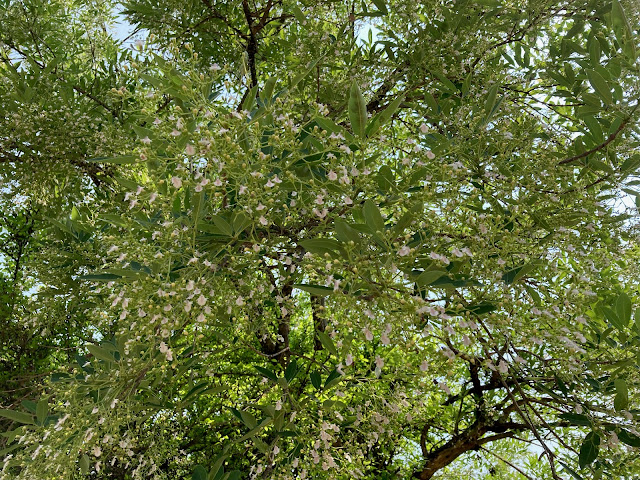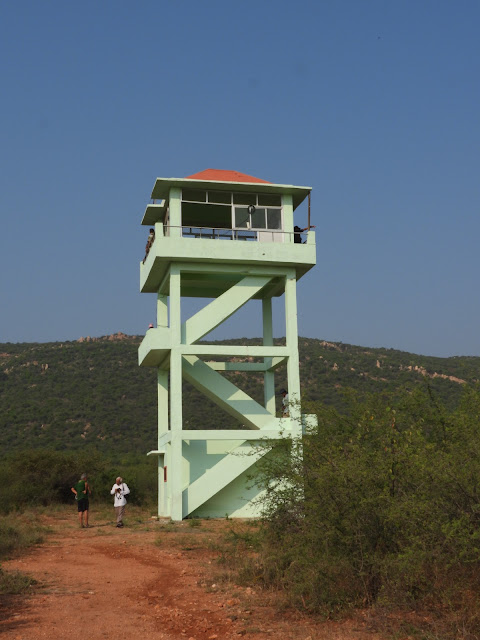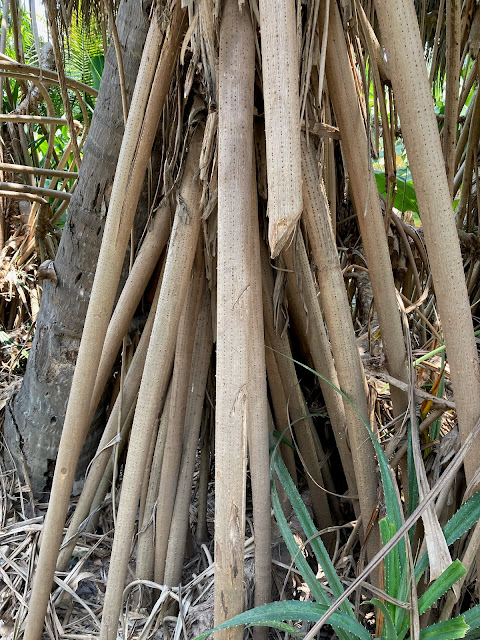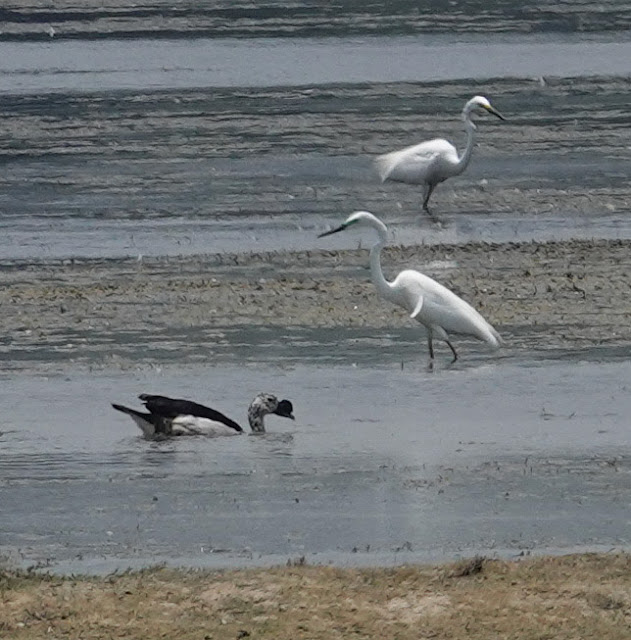Butterfly Walk for MNS Members – The Theosophical Society – July 29, 2023
By Sagarika
It was a nice and sunny Saturday morning, 20 of us gathered in TS for the Butterfly Walk led by M. Yuvan. Theosophical Society post rains is an amazing place; we could notice butterfly activities the moment we stepped into their premises.
The ‘Butterflies of Chennai’ booklet by Palliyur Trust and a sheet on depicting all the key Butterfly Behaviour – from nectaring to mud-puddling to chrysalis was distributed as we waited for everyone to join in.
 |
| Under the Premna tree, with the morphs of the Common Emigrant being shown by Yuvan. |
Yuvan started his briefing by sharing how he has been following butterflies and insect for last few weeks, and how the onset of the SW monsoon leads to a migration not only of butterflies but also of various other insects towards the Eastern coast.
He asked us to try and observe the different behaviour of the butterflies, going beyond just the name/ id. ‘’Know the name and then forget the name’’- that really set the tone for the Walk.
We started off by observing activity around a Premna tree, the group quickly spotted Lemon Pansy, Common Leopard, Tailed Jay and Common Jay. Yuvan went on to show the eggs and caterpillars of Emigrant as well as Tawny Coster. A floating Great Eggfly distracted some of us for few seconds before disappearing into the tree canopy.
It didn’t take much time for us to realise that the patches of Tridax had maximum congregation of different butterflies, the so-called weed is truly a butterfly magnet.
Through the Walk, Yuvan pushed us to observe more - observe the wings, the flight, the antennae, the height of flight.
I was surprised to learn that butterfly’s flight is very different from that of bird. Butterfly wings clap above to generate thrust, unlike birds who get majority of the thrust from the downstroke.
The Walk was filled with many interesting observations and discussions about various aspects of butterfly behaviour. Some key learnings were:
– Tawny Coster - male butterflies utilize a mechanical tactic – a mating plug or copulatory plug to reduce female re-mating.
 |
| Turnera subulata - White buttercups, favourite plants of the Tawny Coster, a more recent adaptation. We saw the Coster female looking to lay eggs on its underside. |
– Multi-generational migration of butterflies – each stage carried out by new generation of adults.
– Poisonous butterflies – Common Crow, the Tigers, the one which we see commonly around are all poisonous!!
– ‘Time compensated sun compass’ of butterflies which help them to understand their location in the world.
– Older generation of Crimson Rose migrate to Sri Lanka, never to return. Usually migration is round trip, in this case it seems to be dispersal enmasse post breeding boom.
Besides butterflies we saw many other insect like robber flies, stink bugs, spider hunter wasp, cricket hunter wasp, blue banded bees, beetles, ants, and grasshoppers of various kinds. The masked crab spider with a wasp hunt took many of us by surprise.
 |
| The Little Clown grasshopper nymph was my favourite. |
 |
| What looked like a wasp - Oreumenoides edwardsii - sitting on a flower... |
 |
| ...was actually a prey captured by a Crab Spider about a quarter of its size. Basically the spider just sucks out all the living juices off the wasp...quite gruesome to visualise this. |
 |
| Indian Green Lynx Spider and spiderlings |
On our way out, we saw Lime Swallowtails mud-puddling on a patch between the bushes. Some of us went on to spend few moments admiring the giant Sterculia apetala before calling it a day.
And just when we thought that we are done with the sightings, a Great Orange-tip floated into the Periwinkle for nectaring, and we all gasped at its sheer size. What an exciting finale!
The Walk lasted for close to 3 hours. We spotted 37 species of butterflies and umpteen other insects.
We are grateful to MNS member Geetha Jaikumar for all her support, without which this wonderful Walk wouldn’t have been possible and to Yuvan whose passion for nature made this Walk so much more meaningful.
BUTTERFLY LIST
Papilionidae
1. Common Jay
2. Common Mormon
3. Crimson Rose
4. Lime Swallowtail
5. Tailed Jay
Pieridae
6. Common Emigrant
7. Plain Orange-tip
8. Great Orange-tip
9. Psyche
10. Common Albatross
11. Common Grass Yellow
12. Small Grass Yellow rose
13. Three spotted grass yellow
14. Indian Wanderer Lycaenidae
15. Small Salmon Arab 16. Common Gull
Nymphalidae
17. Common Crow
18. Blue Tiger
19. Plain Tiger
20. Striped Tiger
21. Lemon Pansy
22. Yellow Pansy Hesperiidae 23. Angled Castor
24. Tawny Coster
25. Common Leopard 26. Great Eggfly
Lycaenidae
27. Common Pierrot 28. Zebra Blue
29. Lesser Grass Blue 30. Indian Sunbeam 31. Tiny Grass Blue 32. Forget-me-not
Hesperiidae
35. Indian Skipper
36. Oriental Straight Swift 37. Marbled Skipper
More photographs of the butterflies here.
Day 4: 20 April 2023
By Gayathri R
(My comments in italics)
 |
| Before wandering in to the bus, I stared curiously at the grasses
there, which seemed all knotted, as if some creature had been at work
building a nest. |
Padhaneer!
 |
| The hero of the morning was Borassus flabellifer, the nungu tree, our state tree, ignored for most of the year, until it is nungu season! |
As we got into the bus, Vijay announced he had a sweet surprise for us. The bus came to a halt on the highway, along an avenue of Palmyra - and Padhaneer was announced. The boys were dubious as was I, the men were gleeful, the women sceptical, but everyone curious.
Nungu was a favourite summer pastime at my grandparents' home in Coimbatore, but what was this padhaneer? Wasnt it like pre-fermented toddy? Shouldn't we be careful?
 |
| By the time these questions went through my head, everyone was busy slurping, a long line had formed each with one of these delightful cups. |
I had a first tentative sip, oh!! it was delicious! - Sweet, malty, grainy and cool!
 |
| Clay pots are placed under the flower fronds and the sweet sap collected early in the morning. When fermented, this turns into toddy (was my understanding). |
 |
| The tools of the trade, to clumb up, pierce the fronds and tie the pots |
 |
| These cups - so aesthetic. |
KMTR and the Sorimuthu Iyyanar Kovil
The Kalakad Mundanthurai Tiger Reserve (KMTR) has been on my wish list for more than a decade. This reserve is part of the Agasthyamalai Biosphere Reserve, which straddles Kerala and Tamil Nadu. If I remember right, Thanikai mentioned how the Thamirabarani originates within the KMTR. If I remember right, Isakki mentioned there were 13 rivers, including the Manimuthar, Ganga and Kallar in this region. The main species being protected was the LTMs - Lion tailed Macaques - and later tiger.
The landscapes vary from moist to dry, and Kakachi was also part of the overall area was how I understood. We were off to the Sorimuthu Ayyanar kovil area - for which special permission is not needed. So we did not go into any "non public" places.
 |
| We crossed several canals and streams - all part of the wider Thamirabarani network. Past Kalidakurichi and Ambasamudram. We were soon winding up the hills. It was a dry April scenery. |
 |
| A watchtower had to be climbed, and what a breathtaking anorama, of the forests, the temple, the rocks and the river. |
 |
| The bridge across the Thamirabarani |
 | ||
| With the temple at the far end of the rocks. |
 | |||
| Amidst the rocks, these plants were growing. |
 | ||
| As we crossed the bridge and headed to our bus, to return for breakfast, we saw this clump and a board. |
 |
| Euphorbia susan-holmesiae - a Cactus native to this region, and is also endangered. |
 |
| Vitex leucoxylon - identified by Thanikai as Neer Nocchi (tamil name). |
Breakfast, tree climbing and the most gorgeous Laburnum I have ever seen

 |
| The banyan - boys and girls climbed, many ladies swung - including Raji, with the most gleeful expression on her face. I did not attempt it. |
 |
Back to Singampatti for a final dip in the river - it was HOT, and I had much travel ahead of me, so like a responsible adult (for a change) I decided to stay out of the sun and the water. I watched the antics of the Greenish Leaf warbler instead. This was the better dipping point - stronger water flow, and deeper as well - there was a mid-river ladies conference as well, it was wonderful to see. Also impressive is the magical changing routines pre and post bath that the ladies managed.
 |
| It called, and chirped, and Aravind, Shashank, Sagarika and I followed it around. Photo by Sagarika |
 |
| Photo by Sagarika |
And so we returned back to our dorms, to pack and eat and rest before leaving. Samrudh went off spider hunting within the campus along with Sagarika, the other boys played cricket.
The spiders are in this link.
Gayathri sums it up best:
We then came back and thanked everyone who crafted a spectacular journey, extending their hospitality. After delightful lunch with payasam, we started packing for our return trip. With loads of memories and authentic Tirunelveli halwa, we bid good-bye to the magnificent Thamirabarani landscape with high hopes of returning back. Below is a group photo of us in the campus.
Thanks to all the members of the group for sharing the sightings list, pictures and offering a lovely company. Thanks to Sagarika for her valuable feedback during report making. Special thanks to Vijay sir for organising this awesome trip.
PS: Raji got off at Tiruneveli - Janakiraman hotel to spend an extra day temple visiting, so no return adventures with her. There was a rowdy and raucous "goodbye" that resounded all through the bus as she alighted. After dropping her, we seemed to go round and round, seeing the same streets, as there were one way streets.
Chitra and I had a chocobar in the station, with much glee.
No Snorer in our compartment, so we slept well, and got off at Egmore, said goodbyes, and made our way together across the city - Mr Shankarnarayan, Chitra, Sheila and me. It is always difficult to say goodbye.
The iNaturalist species list
https://www.inaturalist.org/lists/4402490-Tirunelveli-Trip?view=plain
Day 3: 19 April 2023
By Gayathri R
(My comments in italics)
Vijay had warned that it was a long hot day, and we were all to be prepared.
The sanctuary is a dry deciduous forest and the flora includes thorny hardwood and xerophytes: Dalbergia horrida, Dichrostachys cinerea, Vachellia horrida, Acacia planifrons, Albizia amara, Zizyphus. The place also hosts spotted deer, jungle cat, mongoose, black naped hare, scaly anteater(pangolin), vipers and rat snakes and nearly 100 other species of birds are found in the area/
 | |||||
| We reached and climbed down from our bus into the searing dry heat, and up to the tower. |
Thanikai explained the importance of the scrub and how this 16sqkms is like the last and southernmost refuge for the Blackbuck, with a hillock on one side and the highway on the other. It is important for such scrub habitats to be preserved, but I did wonder about this isolated sanctuary and what it meant for the population of Blackbuck, cutoff from other populations and inbreeding.
 |
| From up there, as we scanned the sanctuary, I saw a beautiful Paradise Flycatcher, a brown shrike, a skulking coucal and a Collared Dove, besides the 6 0r 7 Blackbuck fawns. We did not spot a male. |
 |
| Photo by Sagarika - The Blackbuck fawns |
 |
| The brown shrike - lovely capture by Sheila. Observe the thorns of the Acacia! |
 |
 |
| Photo by Sagarika - We saw this Agamid. I gave it a casual once over and walked on.... |
Many more of the interesting flora and fauna are on iNaturalist, here.
All were picked up from different parts of the track, and a slightly cranky and hot group got into the bus and headed to the Range Office, where our breakfast awaited. A few puris later, everyone's spirits were up again! Hats off to the remarkable team at Atree who kept us fed and hydrated - the age range of our group was from some 10 years to around 70 I guess, and between Vijay's remarkable people management and Thanikai and group, all diverse needs were taken care off! The drinking water arrangement was interesting - I had never seen this handy little battery operated "pump" that fitted on top of the 20 litre water can, enabling us all to keep refilling our water bottles. The Range Office also had a set of toilets, and soon we were all set to depart.
There was a Pied Crested Cuckoo at the rear of the campus, which I did not see as I was busy with the puris. Some others were smarter- they managed the puris and the cuckoo.
Therikaadu - the red desert.
What an amazing landscape! I had read about it before our trip, but nothing quite prepares you for the sight - red sand, dunes and searing heat in the middle of peninsular India!
 |
| Situated close to tiruchendur, and just 15-20 kms from the coast, Therikaadu appears like this huge red Martian area in the middle of TN. |
 |
| We climbed up dunes like this. |
 |
| We gathered up around Thanikai, under the shade of a cashew to understand the geology of this place. |
Hrishu was given the taske of telling us what he knew. Here's how I understood it - the land breezes blowing down the Nilgiris erode the laterite rocks carrying fine sand. These winds collide with the sea breezes blowing in the opposite direction, and this has caused the red sands to get deposited here over centuries.
The "Aeolian Process" is detailed here.
Now these were just plain sand dunes with nothing growing on them. But these are shifting sand dunes, which does not suit humans who want to deal with certainty and stability. So, we have tried to "control" the shifting it appears. How to prevent the dunes from shifting onto agricultural land? Wind Breaks and Shelter Belts are being tried, it seems. The cashews, casuarina and Palmyra are all planted more recently - even Neem has been tried, along with Kodakupuli.
 |
| It was too hot to linger on the dunes and we all moved from bush to bush seeking shelter. i could almost feel the sun dehdrating me, drawing the waters from my body, sucking me dry!! |
 |
| I tasted cashew fruit for the first time - it was too astringent for my liking, though full of water. |
We were all grateful to sink into the bus seats, and turn on the airconditioning as we headed to our next stop.
We made our way to the Arunjunai Katha Ayyanar Thirukkovil which comprises of sacred groves, century old trees, ponds with lots of water birds.
 The sands were red here also - it is the periphery of the Therikaadu. Thanikai explained how this was a land of "eris" - lakes and ponds, some as large as an ocean, with some 30 villages around the periphery. There is no connection between these rainwater tanks and the Thamirabarani river.
The sands were red here also - it is the periphery of the Therikaadu. Thanikai explained how this was a land of "eris" - lakes and ponds, some as large as an ocean, with some 30 villages around the periphery. There is no connection between these rainwater tanks and the Thamirabarani river.
The tanks hosted temples and the trees around became sacred groves, protected by the people.
Thanikai explained that the palm trees, Screw pines (kewras) and Barringtonia groves were all very old and made for an interesting array of landscapes. A 400 year old Naval (Jamun) was also around. And the ponds and tanks were filled with birds.
 |
| We saw this large peepul surrounded and protected by stone deities including this Ayyanaar which was quite magnificent. |
 |
| The Barringtonia roots were stunning, and stood tall along with kewras - roots seen in the picture, indicating the presence of water, even if they were dry in April. |
It was very warm and humid, but under the tall trees we were fine. The road was filled with tamarind trees as well. Lyra and Neil had discovered an interesting shoe stamping game - interesting for them I mean. They were keeping score, much to my amusement.
At one point, we rounded the corner, and suddenly there were no tall trees, just a long road with large tanks on either side, filled with water birds, standing listlessly in the ponds. For some reason, at this point my body battery ran out, and I just felt extremely tired and drained. I dragged myself from tree cover to tree cover, for a bit. We saw both the jacanas, grey herons in plenty as also Brahminy Kites.
 |
| But the biggest excitement was for the Comb Ducks - recognisable with their larger size, but far away in the distance. (Sagarika's Photo) |
 |
| Lunchtime, came the welcome announcement, and we skulked by the short cut back to the Arunjunai Katha Ayyanar Thirukkovil, where we started. See the way the temple envelops the Arjuna tree within it. |
 |
| Mr Shankarnarayan's Picture of the beautiful Ayyanar from the Arunjunai Katha Ayyanar temple |
At around 3 PM we reached Punnakayal, a small fishing town. This is the place where the river Thamirabarani meets the sea.
 |
| Boats were coming in with all sort of catch. |
 |
| We witnessed a quick and efficient auction of this load of octpuses, |
 |
| as also these mussels, which were being exported to China. I wondered about the sustainability of this all, but of course I have no idea, and I am hoping the local fisherfolk know better. |
 |
| Conspicuously absent at this time of day were the women - I did not see a single one. |
 |
| We sighted Brown-headed Gull, Black-headed Gull
and many Brahminy Kites. (This brown headed Gull photo by Baskaran) |
We were taken to a small island patch where we walked around and found beautiful shells of sea-urchins, colorful shells and flora unique to the ecosystem. We tasted a small leaved plant which the fisher-folks said would be a bit salty.
One other interesting behaviour we observed was of a Brahminy Kite. It was hovering above us eating the fish it held in its claws.
We could see it in close quarters and clicked some good pictures. Other birds spotted on this day was White-eyed Buzzard, Ashy-crowned Sparrow Lark, Great Thickknee, Whimbrel, Western Marsh Harrier and Western Reef Egret.
 |
| We returned around 6pm, and witnessed a beautiful sunset as well. |
The journey back was long and we reached our stay at 9 PM. We had dinner and some of us (not me!) went for a night walk with Mr. Thanikaivel, escorted by Gingee, the pet dog there. We saw 3 vine snakes, scorpions with it’s young ones, a small white-breasted waterhen sitting on a tree and a Indian Black Turtle along the waterbody.
I visited 2023 November, so it has been close to a year . 26th October 2024 8-10am To my delight, I discovered a skywalk across the Sarjapur...
